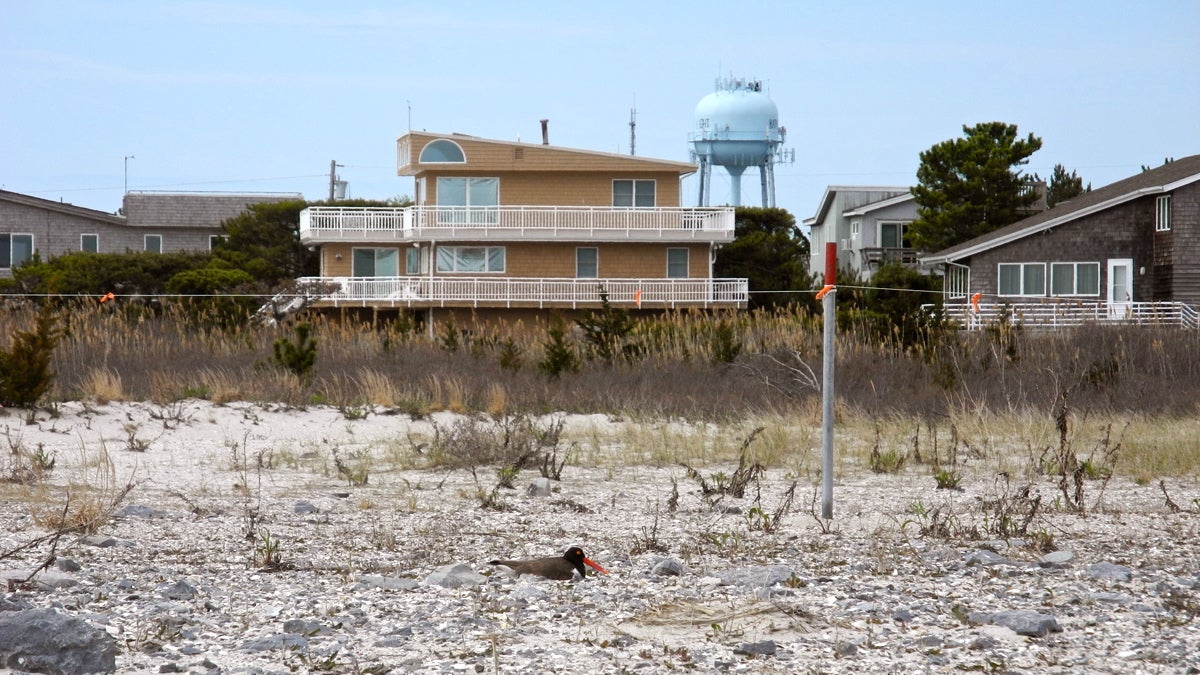After Sandy, balancing the needs of nesting birds and people
Listen
An American oystercatcher nests in Barnegat Lighthouse State Park on Long Beach Island. (Tracy Samuelson/WHYY)
A small gray bird crouches in the sand at Barnegat Lighthouse State Park. Except for its bright orange beak, the American oystercatcher is difficult to spot among the sand and shells.
It’s nesting season for many endangered or threatened species of birds at the Jersey Shore, including the oystercatcher, black skimmers, least terns, and the hard-to-spot piping plover.
But this important time for the birds happens to overlap with tourist season, an important time for the Shore’s economy. People and nesting birds often have trouble sharing the beach. After Superstorm Sandy, that balance has become even more complicated.
In some places along the Shore, Sandy chipped away at habitats where shorebirds like to nest. But in other areas, the storm actually created or improved new nesting spots.
In recent years, only 100 to 120 pairs of piping plovers have nested in the entire state, according to Brooke Maslo, a professor and researcher at Rutgers University. Historically, Barnegat Lighthouse State Park has typically hosted just one pair. In the wake of Sandy, two — maybe three — pairs of piping plovers have taken up residence in the park, thanks to changes brought by the storm.
“This was a large dune prior to Sandy,” says Todd Pover, the beach nesting bird project manager for the Conserve Wildlife Foundation of New Jersey. The storm “flattened it. It created this more sparsely vegetated, shelly area that the plovers prefer.”
Plovers like to plop their nest right on the beach, out in the open, where they can see predators coming and where their beige and gray coloring helps them blend with sand and shells.
In addition to Barnegat Light, Maslo and Pover also point to new and improved habitats in Holgate, as well as a stretch between Avalon and Stone Harbor.
However, new habitat created from Monmouth Beach to Sea Bright – where Sandy leveled a dune in front of a sea wall to make a good sandy area for the birds – disappeared when the dune was rebuilt.
“But now, this protective dune in front of the sea wall is there,” say Maslo, describing the rebuilt dune. “And to date, we haven’t seen any birds. There were, I’d say, three pretty active nesting locations within that stretch.”
In addition to cataloging Sandy’s impact on beach habitat, Maslo and Pover are trying to create a protocol to quickly identify and preserve new habitat created after future storms.
“It’s definitely a big balancing act,” confirms Beth Brandreth, a biologist and endangered species coordinator for the U.S. Army Corps of Engineers. It’s her job to try to marry the needs of people and birds, which isn’t always easy, she explains, calling herself the “great negotiator.”
“I try to make sure that our end product is something that accomplishes our flood-protection goals but then is also protecting the species and enhancing any habitat,” she says.
Brandreth says the Army Corps limits work on beaches during nesting season and builds thousand-foot buffer areas around any nest it does do find. It also requires communities with beach-fill projects to have plans for how to manage the species once the project is done.
Even still, Maslo questions the impact these beach fill projects have on birds.
“Long linear dunes with flat, manicured beaches is not an ecosystem – it’s more of a lawn,” she says.
Plus, as tides can eat away at the new berms, they can cause steep drops into the water – “the Grand Canyon to a bird that’s only a couple inches tall.”
Maslo and Pover both understand the need to protect people and infrastructure – they’re not saying the birds should come first, just that perhaps after future storms, there could be a way to preserve some of the new habitat created, to let the beaches move through their natural cycles.
WHYY is your source for fact-based, in-depth journalism and information. As a nonprofit organization, we rely on financial support from readers like you. Please give today.




